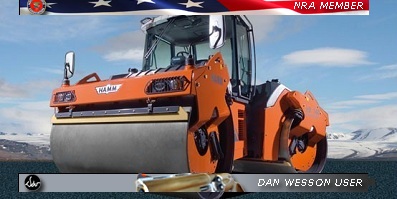
Dans Club
March 2, 2008
 Offline
OfflineI am a dedicated "small frame" DW guy, and I don't mean for this to bash the Large Frame design, but why would it have changed?
For what reason would the basic design have changed into the large frame?
Is the large frame design better suited to more powerful calibers?
Is the small frame design less suited to the big thumpers?
Is the large frame what the DW revolver should have been from the start?
I'd really like to hear some informed opinion on this if anyone wants to jump in.
I went to a bookstore and asked the saleswoman "Were is the Self Help Section?" She said if she told me, it would defeat the purpose.
George Carlin

Dans Club
December 5, 2008
 Offline
Offline
Dans Club

DWF Supporters
April 20, 2010
 Offline
OfflineA good question, I have wondered myself.
The small frame is proven sturdy and maybe the easiest revolver around to work on. Why not just make a bigger version of the same? I do understand the lack of a sideplate makes for a very solid platform.
This could be a good question to throw at Mike Sheehan, sounds like his dad was in on the early development of the .44.
-Lonwolf
"The lion and the tiger may be more powerful, but the Wolf does not perform in the circus"
Supporter

Moderators
January 24, 2009
 Offline
OfflineSMKYTXN said
As a structural engineer I can see the removable side plate on the small frame being a weak point for the higher calibers. The solid sides on the large frame dans are inherently stronger. That may or may not be the reason, but it's one that I can see.
I'd buy into that theory.
Another interesting similarity is that some of the Ruger models share a similar fame design to the large frame DW's. Like my .357 Security Six for example, it is solid on both sides & the trigger group drops out from the bottom...
Some of their other later models use this same design.
August 31, 2013
 Offline
OfflineMy completely unknowledgable guess would be that it was also changed for marketing reasons. When people buy larger caliber handguns, they want a bigger handgun than the rest. You never hear anyone say, "Check out how light and concealable this .44 mag I just bought is. You can't even see it under my jacket." That's just not their purpose. Usually, they are meant to be seen. So while the smaller frames are designed to be more versatile, the larger frames are , obviously, designed to be large. Of course, the larger frame also has a number of advantages. The extra weight soaks up recoil, thus making them easier to shoot, and therefore more accurate at longer distances. Shooting a small frame .44 might be a little more uncomfortable, even though Dan Wesson small frames are actually pretty large.
Not to offend anyone with my blunt post. Without a doubt, I want my next handgun to be a larger caliber Dan Wesson revolver, I just think they are designed for a purpose, and it's not the exact same purpose that the small frames were designed for.

Dans Club
March 2, 2008
 Offline
OfflineDon't worry about offending anyone, we all got pretty thick skins.
I think the integral, no sideplate. one piece frame theory makes sense, especially if the end product was going to be the .41/.44/Supermag. That Small Frame sideplate -vs- a solid, one piece frame makes a lot of sense for the really hard hitting IHMSA and hunting calibers in terms of strength and especially durability.
I went to a bookstore and asked the saleswoman "Were is the Self Help Section?" She said if she told me, it would defeat the purpose.
George Carlin
February 26, 2012
 Offline
OfflineSteve, I'm not an engineer or a gun designer, I don't play one on TV and I didn't stay at a Holidy Inn Express last night but to answer your questions in order: yes, yes, yes, and no.
I refer you to the Ruger Blachhawks and Redhawks. When Ruger first chambered the 44 Mag. in the Blackhawk I understand there was a question of durability. They made the frame larger to handle the added stress of the big mag. With the Redhawk Ruger decided the Security Six/GP 100 frame was not big enough the handle the larger cartridge thus the Redhawk/Super Redhawk. Some of this, I'm sure, has to do with physical size of the cartridge. I refer you to the 500 S&W for example. When Smith brought out the 44 Mag. they put it in the "N" frame which is larger than the "K" frame. By the way the 357 was originally chambered in the "N" frame not the "K".
It's only been the last several years that metalurgy has caught up with the firearms industry to allow chambering the more powerful cartridges in smaller frames.
That's what I've read anyway. I'm sure there are some on here who have more knowledge of this than I do.
Democracy is two wolves and a lamb voting on what to have for dinner. Liberty is a well armed lamb contesting the vote.
February 11, 2010
 Offline
OfflineWe have seen examples here where the large frames were battered. So no, I do not
believe the small frames would hold up to a diet of full house large caliber loads.
Even the S&W N-frame gave silhouette shooters problems. This all of course means
nothing if your the occasional and normal 500 round a year shooter.
-Blacktop

1 Guest(s)

 Register
Register Log In
Log In Home
Home







